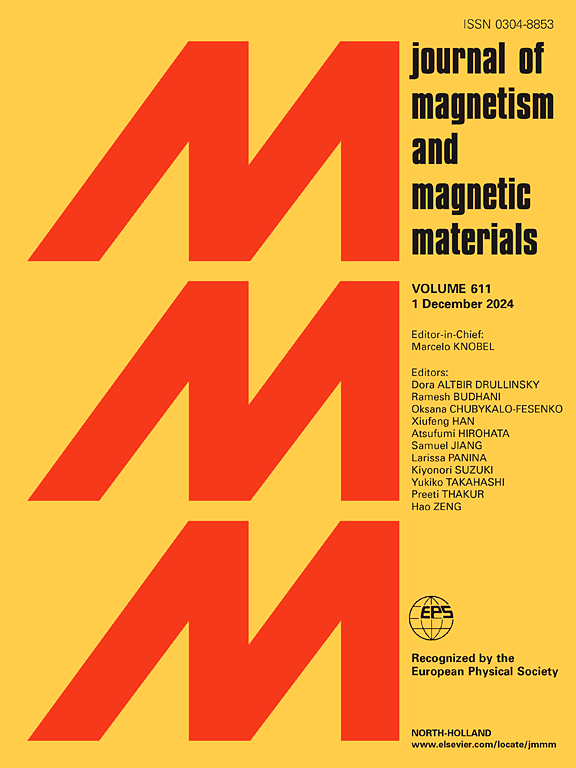Design and performance analysis of magnetic helical robot used for vascular interventions
IF 2.5
3区 材料科学
Q3 MATERIALS SCIENCE, MULTIDISCIPLINARY
引用次数: 0
Abstract
During minimally invasive vascular interventions, the maneuverability of guidewires is usually limited by narrow blood vessels. In this study, we designed a magnetic helical robot capable of overcoming spatial constraints within narrow blood vessels and precisely navigating guidewires to target regions. The structure of the magnetic helical robot consists of a front-end permanent magnet and helical structure, a flexible body structure, and a trailing guidewire. By considering resistance theory in low Reynolds number environments, we developed a dynamic model for the magnetic helical robot and analyzed the relationship between its motion velocity and helical structure parameters. Based on a guidewire deflection cantilever model, we investigated the relationship between guidewire deflections and flexible body structure parameters. Dynamic experiments were conducted on the magnetic helical robot to verify its active locomotion capability and confirm the optimal helical structure parameters. Additionally, guidewire deflection experiments demonstrated that increasing the length of the flexible body structure resulted in a maximum bending gain of up to 30 %, confirming the enhanced deformability of the carried guidewire and determining the optimal length of the flexible body structure. Furthermore, successful navigation experiments of the magnetic helical robot carrying a guidewire were performed in a three-dimensional vascular model, with a navigation error of 0.80 mm, thereby validating the locomotion and capability of enhancing guidewire deflections of the magnetic helical robot. The designed magnetic helical robot in this study provides experimental evidence for minimally invasive vascular interventions and holds promise for application in vascular intervention procedures.
血管介入磁力螺旋机器人的设计与性能分析
在微创血管介入治疗中,导丝的可操作性通常受到狭窄血管的限制。在这项研究中,我们设计了一个磁性螺旋机器人,能够克服狭窄血管内的空间限制,并精确地将导丝导航到目标区域。磁性螺旋机器人的结构由前端永磁体和螺旋结构、柔性体结构和尾部导丝组成。考虑低雷诺数环境下的阻力理论,建立了磁性螺旋机器人的动力学模型,分析了其运动速度与螺旋结构参数的关系。基于导丝挠度悬臂模型,研究了导丝挠度与柔体结构参数的关系。对磁螺旋机器人进行了动态实验,验证了其主动运动能力,确定了最优的螺旋结构参数。此外,导丝挠曲实验表明,增加柔性体结构长度可使弯曲增益最大达到30%,从而证实了所携带导丝的变形能力增强,并确定了柔性体结构的最佳长度。在三维血管模型中成功进行了携带导丝的磁螺旋机器人的导航实验,导航误差为0.80 mm,从而验证了磁螺旋机器人的运动和增强导丝挠度的能力。本研究设计的磁性螺旋机器人为微创血管介入治疗提供了实验依据,在血管介入手术中具有广阔的应用前景。
本文章由计算机程序翻译,如有差异,请以英文原文为准。
求助全文
约1分钟内获得全文
求助全文
来源期刊

Journal of Magnetism and Magnetic Materials
物理-材料科学:综合
CiteScore
5.30
自引率
11.10%
发文量
1149
审稿时长
59 days
期刊介绍:
The Journal of Magnetism and Magnetic Materials provides an important forum for the disclosure and discussion of original contributions covering the whole spectrum of topics, from basic magnetism to the technology and applications of magnetic materials. The journal encourages greater interaction between the basic and applied sub-disciplines of magnetism with comprehensive review articles, in addition to full-length contributions. In addition, other categories of contributions are welcome, including Critical Focused issues, Current Perspectives and Outreach to the General Public.
Main Categories:
Full-length articles:
Technically original research documents that report results of value to the communities that comprise the journal audience. The link between chemical, structural and microstructural properties on the one hand and magnetic properties on the other hand are encouraged.
In addition to general topics covering all areas of magnetism and magnetic materials, the full-length articles also include three sub-sections, focusing on Nanomagnetism, Spintronics and Applications.
The sub-section on Nanomagnetism contains articles on magnetic nanoparticles, nanowires, thin films, 2D materials and other nanoscale magnetic materials and their applications.
The sub-section on Spintronics contains articles on magnetoresistance, magnetoimpedance, magneto-optical phenomena, Micro-Electro-Mechanical Systems (MEMS), and other topics related to spin current control and magneto-transport phenomena. The sub-section on Applications display papers that focus on applications of magnetic materials. The applications need to show a connection to magnetism.
Review articles:
Review articles organize, clarify, and summarize existing major works in the areas covered by the Journal and provide comprehensive citations to the full spectrum of relevant literature.
 求助内容:
求助内容: 应助结果提醒方式:
应助结果提醒方式:


